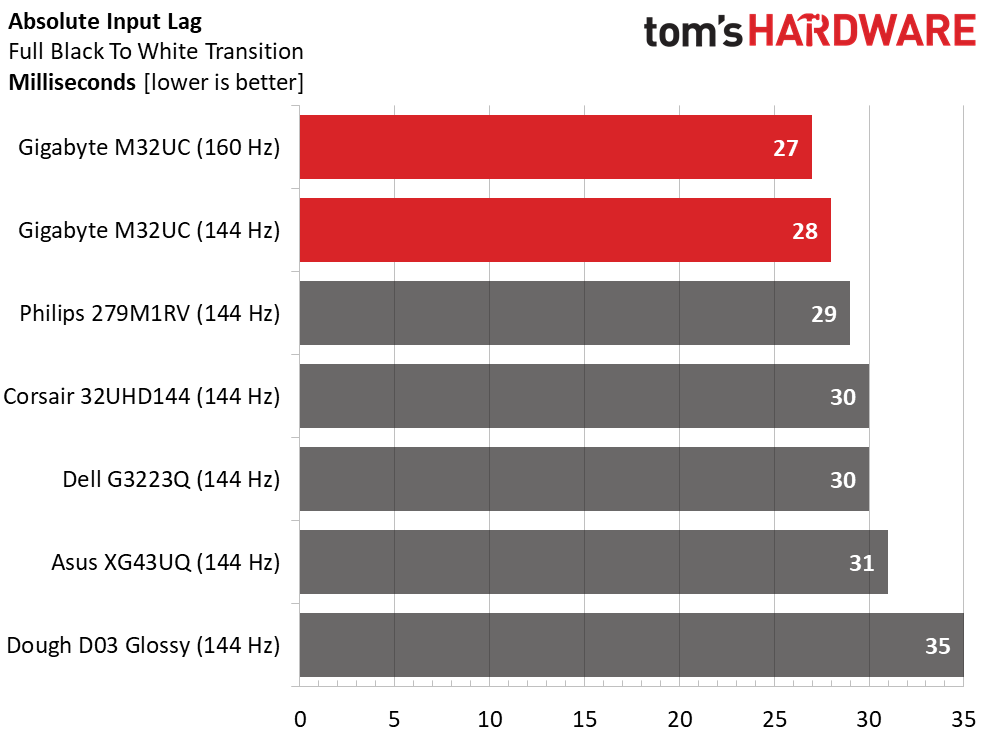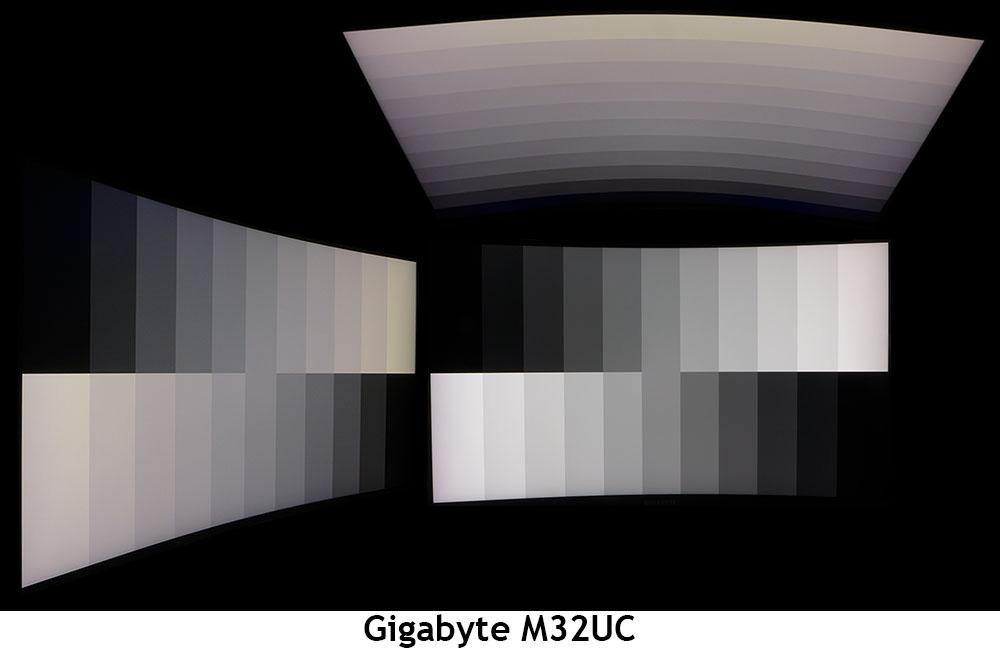Why you can trust Tom's Hardware
The M32UC is the first 160 Hz 4K monitor I’ve reviewed, so I have only 144 Hz screens available for comparison. They are the Philips 279M1RV, Dough D03 Glossy, Corsair 32UHD144, Dell G3223Q and Asus XG43UQ.
Pixel Response and Input Lag
Click here to read up on our pixel response and input lag testing procedures.


To cover all the bases, I’m showing the M32UC’s test results at 144 and 160 Hz. The difference is small and only impacts the lag score. Screen response is the same at 7ms, like nearly every 144 Hz monitor currently available. The Gigabyte delivers smooth motion resolution with the overdrive set to SmartOD. Alternatively, you can use Aim Stabilizer Sync (backlight strobe). It works along with Adaptive-Sync and sharpens the moving image but introduces a slight phasing artifact, reducing light output by 60%.
In the lag test, running at 160 Hz gets you 1ms less input lag. But you’ll give up Adaptive-Sync, which is not a good thing at this frame rate. And don’t forget the video card factor. I can run my test at full speed because it uses a static white field pattern that refreshes at 160 Hz. Seeing that rate in-game will require a lot of processing power, more than my single GeForce RTX 3090 card has. That setup delivers around 120fps in Doom Eternal with detail set at maximum. The takeaway is that the 160 Hz overclock is not a reason to buy the M32UC. Its impact is small at best.
Viewing Angles
VA panel viewing angles are not usually great, and you won’t mistake the M32UC for an IPS monitor. But it looks a bit brighter at 45 degrees off-center than most. Light is reduced by around 20% and there is a red color shift. But detail remains well-rendered, and the picture looks decent in practice. One could share this monitor with a friend. The top view is washed out with the same red color shift.
Screen Uniformity
To learn how we measure screen uniformity, click here.
My M32UC sample showed a slight glow at the top and bottom of the screen. It was visible in a darkened room when a full black field pattern was displayed. I did not notice any problems when playing games or viewing video. White and color field patterns had no visible issues.
Get Tom's Hardware's best news and in-depth reviews, straight to your inbox.
MORE: Best Gaming Monitors
MORE: How We Test PC Monitors
MORE: How to Buy a PC Monitor: A 2022 Guide
MORE: How to Choose the Best HDR Monitor
Current page: Response, Input Lag, Viewing Angles and Uniformity
Prev Page Features and Specifications Next Page Brightness and Contrast
Christian Eberle is a Contributing Editor for Tom's Hardware US. He's a veteran reviewer of A/V equipment, specializing in monitors. Christian began his obsession with tech when he built his first PC in 1991, a 286 running DOS 3.0 at a blazing 12MHz. In 2006, he undertook training from the Imaging Science Foundation in video calibration and testing and thus started a passion for precise imaging that persists to this day. He is also a professional musician with a degree from the New England Conservatory as a classical bassoonist which he used to good effect as a performer with the West Point Army Band from 1987 to 2013. He enjoys watching movies and listening to high-end audio in his custom-built home theater and can be seen riding trails near his home on a race-ready ICE VTX recumbent trike. Christian enjoys the endless summer in Florida where he lives with his wife and Chihuahua and plays with orchestras around the state.
-
cknobman You cannot have HDR without any type of local dimming.Reply
Pretty much false advertisement and should make an instant no recommendation IMO. -
Johnpombrio I own the GigabyteM32U which RTratings names as the best 32-inch 4K mid-range gaming monitor with HDR 10, 144 Hz, and IPS for a year and a half now at $650 on Amazon. Going for VA and curved and the hokey HDR 400 sounds like a big step backward.Reply -
truerock VESA DisplayHDR400 is not HDR - in my opinion.Reply
I take Vesa DisplayHDR400 as a VESA definition of a good-non-HDR monitor for a base comparison to the other VESA DisplayHDR standards. It's a helpful marketing tool.
Really, VESA DisplayHDR500 is the lowest level of VESA DispayHDR - in my opinion.
I've been using a 27", 1080P, 8-bit, 60Hz monitor for the last 12 years. When I upgrade, it will probably be to a 32", 4k, 10-bit, 144Hz monitor, VESA Display500 (with NO speakers). -
expert_vision Reply
@truerock I recently got Dell G3223Q for $500 on black firday and I think it meets all your criterias.truerock said:When I upgrade, it will probably be to a 32", 4k, 10-bit, 144Hz monitor, VESA Display500 (with NO speakers). -
truerock Replyexpert_vision said:@truerock I recently got Dell G3223Q for $500 on black firday and I think it meets all your criterias.
Thanks... but, I don't think that monitor is VESA Display500. -
expert_vision Reply
It says it's VESA DisplayHDR™ 600. Is that not better than 500?truerock said:Thanks... but, I don't think that monitor is VESA Display500.
Or are you reffering to the lack of local dimming? In that case, yeah, it lacks.
Personally, I don't care about HDR. I have it disabled and brightness set to 0-10%, lol.

